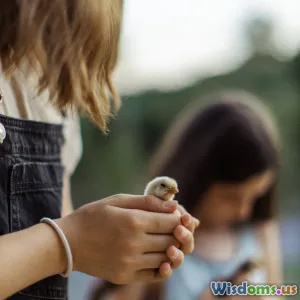
Debunking Common Myths About Hand Taming Young Birds
8 min read Uncover and challenge the myths surrounding hand taming young birds with proven techniques and insightful advice. (0 Reviews)
Debunking Common Myths About Hand Taming Young Birds
Hand taming young birds can be an incredibly rewarding experience for bird enthusiasts and pet owners alike. Yet, the process is often shrouded in misconceptions that discourage many from trying or doing so effectively. This article peels back the layers of these myths to offer clear, science-based guidance and real-world insights for anyone keen to form loving relationships with their young avian companions.
Introduction: The Fascination and Challenge of Taming Birds
Birds are captivating creatures—intelligent, curious, and delicate. The ability to tame and hand-raise them not only deepens your connection but can greatly improve their socialization and well-being. However, many myths cloud the process. Is it too difficult? Are young birds too fragile to handle? Will taming cause harm to their development? These questions often generate hesitation. Let’s illuminate the truth.
Myth 1: You Must Begin Hand Taming at Birth for Success
The Reality: While starting early is beneficial, taming isn’t exclusively reserved for hatchlings. Many experienced aviculturists report successful taming when beginning with juveniles or even adult birds.
Why Early Is Preferred – But Not Absolute
Starting hand taming soon after hatching leverages the bird’s critical socialization period—a window where exposure to human interaction can shape lifelong comfort. Puppies and kittens have similar windows; birds do, too.
According to Dr. Irene Pepperberg, renowned avian cognition researcher, juvenile birds exhibit greater neuroplasticity, making them more adaptable to new experiences. However, birds retain learning abilities into adulthood, allowing for taming beyond the neonatal stage.
Real-World Insight
Bird owner and breeder Linda M. successfully hand-tamed a six-month-old parakeet by gradually introducing touch and positive reinforcement. Her experience shows patience and consistency often outweigh the bird’s age.
Myth 2: Hand Taming Requires Handling the Bird for Hours Daily
The Reality: Quality matters more than quantity. Excessive forceful handling can stress young birds, setting back trust instead of building it.
Balancing Interaction with Rest
Birds, especially young ones, require downtime to develop properly. Harvard avian physiologist Dr. Mark Johnson highlights, “Overhandling can activate stress responses causing fear-based behaviors, undermining taming attempts.”
Short, calm, and rewarding sessions—typically 5 to 10 minutes a few times a day—yield better outcomes than prolonged forced interaction.
Example Technique
Stepwise progression, such as offering treats with an open hand and allowing approach on their terms, fosters trust efficiently without overwhelming the bird.
Myth 3: Using Force or Restraint Is Necessary to Establish Control
The Reality: Gentle respect and positive reinforcement far outperform force. Birds are sensitive to tone and touch and can remember negative experiences.
The Importance of Positive Reinforcement
Rewarding good behavior using treats or gentle praise boosts the bird’s willingness to interact voluntarily. The clicker training method used by many expert trainers offers proof—consistent positive cues lead to desired behaviors without stress.
Dr. Sophia Young, an avian veterinarian, emphasizes, “When taming young birds, the goal should be trust, not control. Force erodes this fragile bond.”
Case Study
A parrot sanctuary used non-coercive training and saw rapid socialization improvements compared to previous forced methods, echoing a global trend toward humane training.
Myth 4: Hand Taming Is Dangerous and Can Harm a Young Bird’s Physical Health
The Reality: When done properly, hand taming supports young birds’ emotional health without compromising physical well-being.
Risks Stem From Misinformation, Not Taming Itself
Proper hygiene, gentle handling, and knowing signs of distress are critical. Neglecting these creates risks, but the taming act itself does not.
Avian experts advocate for observational learning—bird caretakers should watch for signs like fluffed feathers, rapid breathing, or refusal to eat to adjust their methods.
Evidence-Based Care
Multiple avian welfare organizations encourage hand taming as part of enriching captive bird environments, noting improved mental stimulation and enhanced resilience.
Myth 5: Hand-Tamed Birds Lose Essential Natural Behaviors
The Reality: Taming does not erase instincts; it enhances communication and social bonding without hindering natural behaviors.
Natural Behaviors Coexist with Tameness
Hand-tamed birds still flock, forage, and sing naturally. Balancing social interaction with environmental enrichment preserves innate behaviors.
Conservationists at the World Parrot Trust highlight that hand-raised parrots often demonstrate normal social play and problem-solving skills, essential for their psychological health.
Practical Advice
Owners should provide toys, perches, and safe outdoor time (if possible) to maintain natural instincts while enjoying the benefits of tame companionship.
Conclusion: Embracing Truth to Foster Strong Bonds
Hand taming young birds is a delicate dance between patience, understanding, and respect. Dispelling myths allows caregivers to approach this rewarding journey equipped with realistic expectations and effective strategies.
Key takeaways:
- Start taming early but know it’s never too late.
- Quality, brief sessions build trust better than excessive handling.
- Positive reinforcement beats force.
- Proper hand taming is safe and fosters emotional well-being.
- Tameness coexists with natural bird behaviors.
By blending scientific findings with compassionate care, anyone can nurture a young bird’s trust, unlocking years of joyful interaction and mutual affection.
References
- Pepperberg, I. M. (2013). The Alex Studies: Cognitive and Communicative Abilities of Grey Parrots. Harvard University Press.
- Johnson, M. (2020). Avian Stress Physiology: Understanding Bird Responses in Captivity. Journal of Avian Medicine.
- World Parrot Trust. (2021). Bird Enrichment and Welfare Guidelines.
- Young, S. (2019). Behavioral Conditioning with Companion Birds. Avian Veterinary Journal.
- Linda M. (2022). Personal Communication on Hand-Taming Techniques.
Hand taming young birds is a journey enriched by knowledge, empathy, and the joy of connection. Dispelling myths is the first step to unlocking the true potential of this unique relationship.
Rate the Post
User Reviews
Other posts in Animal Behavior
Popular Posts















